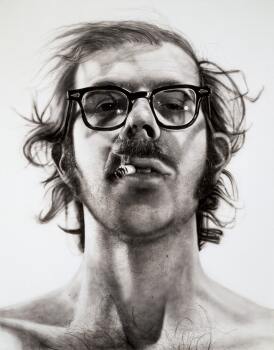About Photorealism
What is Photorealism?

Photorealism describes a highly realistic style of art that emerged in the late 1960s and early 1970s in New York and California. Using photographic images rather than direct observation as the primary visual reference, artists employed a variety of techniques to achieve stunning levels of verisimilitude. The movement was not organized in any formal way; rather, it emerged organically through the roughly contemporaneous experiments of a largely unconnected group of artists. Informed by Pop Art and Minimalism, the Photorealists similarly reacted against the individualism and spontaneity of Abstract Expressionism, favoring meticulously planned and executed portrayals of quotidian life. Emphasizing technical prowess and virtuosity, Photorealism represented the ultimate rebuke to abstraction in its exaltation of representational imagery.
Meticulously detailed and uncannily realistic, Photorealist art concerns itself not with representing the world as it actually exists, but as it is seen by a camera.
Characteristics & Style of Photorealism

Meticulously detailed and uncannily realistic, Photorealist art concerns itself not with representing the world as it actually exists, but as it is seen by a camera. Accordingly, the genre is typified by a sense of detachment and visual coolness, with smooth, un-painterly surfaces underscoring the lack of affectation. Unlike tromp l’oiel, with which Photorealism is sometimes erroneously confused, no attempt is made to fool the eye; the viewer’s awareness that they are looking at a two-dimensional painted image is in fact central to the Photorealistic effect.
To achieve the highest degree of representational fidelity, artists would typically project and enlarge photographic images directly onto the canvas, using gridding techniques to precisely replicate every detail. Others combined multiple photographic studies to complicate the sense of compositional depth. Emphasizing technical acumen over heroic self-expression, reflective surfaces like glass and chrome make frequent appearances; mundane subject matter – from industrial machinery and icons of consumer culture to closely cropped head-on portraits – further highlight the sense of anonymity.
Legacy of Photorealism

Advancements in photography presented a unique challenge to the visual arts, and for realist painting in particular. In its nascence, the Photorealist movement was met with considerable criticism for its reliance on the photographic image, which critics dismissed as copying rather than creating. The style, however, eventually gained widespread acceptance. No longer the enemy of “high” art, the camera could be leveraged as an important tool in the artistic process, a development which has had far-reaching implications for both painting and photography. In the immediate wake of Photorealism, a new generation of Hyperrealist artists like Denis Peterson leveraged advancements in high-resolution photography to achieve heightened levels of detail, further complicating the notion of realism by mixing the seemingly objective with the artificial and subjective. Today, Photorealist tendencies continue to influence a diverse array of contemporary artists, including Richard Prince, Andreas Gursky, Jeff Koons and Kehinde Wiley.
Timeline & History of Photorealism
Artists
Who are the Photorealist Artists?
Working largely independently, the original group of Photorealists emerged chiefly around New York and California. Among the most influential, Chuck Close is known for his giant, systematically rendered mug-shot style portraits; Richard Estes, for his gleaming, meticulously detailed cityscapes; Ralph Goings, for his sharp portrayals of diners, pickup trucks and gas stations; and Audrey Flack, the sole female practitioner, for her vibrant still-life arrangements. While the style is predominantly associated with painting, a number of sculptors also worked in the Photorealist idiom, including Duane Hanson, known for his eerily lifelike sculptures of everyday people.
Photorealists at Auction
Have Something to Sell?
Have Something to Sell?
Get Started




















